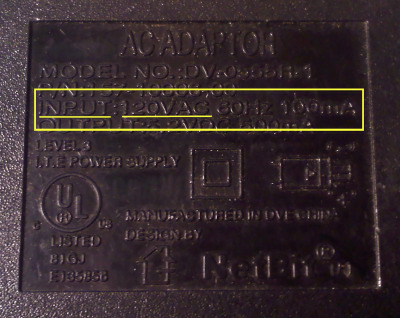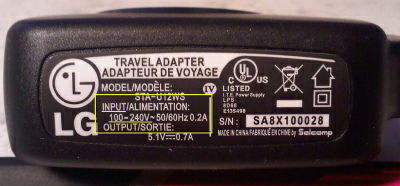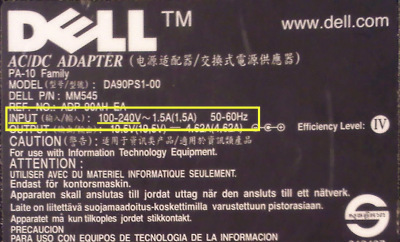



The Files:The GalleryOther Pages
|
15 March 2009The Theory of Power:One of the things that confuses and flumixes people when they travel is the fact that outside of North America countries have a different philosophy about electrical power.Here in the US and Canada we use 110 volt AC power for our every day appliances like lamps and televisions, and only use 220 volt power for heavy appliances and tools like ovens and clothes driers. Most of the rest of the world uses 240 volt power for everything we use 110 volts for. This may seem odd, but there is a good reason. I'm not going to turn this into a history lesson, nor am I going to try to teach you electrical theory 101, but I will give you a little bit of info and you can read more if you feel the urge. I do want to explain the basic reason the 240 volt mains power standard is used, though. Simply put: It is cheaper. You may or may not remember the equation Volts X Amps = Watts. Simply put, the number of volts (110 or 240) times the amps the appliance draws equals the watts it consumes. What that means is that your 1800 watt hair dryer designed for 110 volt power draws around 16 amps. (1800 watts divided by 110 volts equals 16.36 amps) But a hair dryer of the same 1800 watt consumption designed to run on 240 volt power will only draw 7.5 amps. (1800 watts divided by 240 volts equals 7.5 amps) Fine, you say, but how does that make it cheaper? Simple: The higher the wattage you need a wire to carry, the bigger the wire has to be. Wire is usually made of copper or an alloy of copper. Copper costs money, so if you can make do with thinner wire (and use less copper) safely, you save money. You may notice that the power cords on some of the every day appliances you will see in 240 volt countries look kinda thin. They are, but they are just as safe as the big cords we are used to. Wiring doesn't care about voltage, it cares about amperage. Take, for example, the wire you would find in the wall socket of your home in the US. It is likely to be 14 gauge wire and is rated for a 15 amp circuit. That 1800 watt hair dryer we talked about earlier is going to be pushing the rating (Don't worry, there is a bit of safety margin baked into the standards used for wiring. The power in your house is likely really 120 volts, not 110 volts, so the equation is changed a bit. And the real limit for 14 gauge wire is around 20 amps anyway.). Now, the same wiring using 240 volt mains and the 240 volt, 1800 watt, hair dryer would only be pulling 7.5 amps through the wire. You could plug in your 1500 watt space heater and warm your bum while you dry your hair and still not trip the circuit breaker. The Plugs and SocketsEach country seems to have its own take on which type of plug and socket arrangement is the safest, so there is great variety in the plugs you will find in different countries. In Afghanistan, I found that the locals used the European two prong style. But, on coalition bases you would find everything form the three pronged Type B of North America to the modern Type G of the UK.Here is a site that will help you figure out the common socket types for most every where on the planet. Beware, especially in third world countries, for regional exceptions to the "standard" plug types. If a local merchant gets a deal on non-standard sockets he may have taken it and you'll find that an area is using something different than the rest of the country. So, what does this mean?Well, I have yacked at you for a fair time about the whys and wherefores. But what you really want to know is: What do I need to do to make sure I can charge my MP3 Player and use my Computer in lower Elbonia?Here is what:First, check all your electronics for what their voltage requirements are. If you plug a 110 volt appliance into 240 volt power you will definitely let the magic smoke out.Each and every device has a label on it that identifies what voltages it is designed for. Since most of our electronics today are made in Asia for the world market, most of them have dual (110~240 volt) voltage capability. Here are some pictures of these labels for your reference: This is the charger to my Palm Tungsten E2. This little critter gave me fits, because I stupidly assumed it was dual voltage, and it wasn't. I had to find a voltage converter in Afghanistan so that I could charge my Palm. Luckily the PX had 100 watt converters for $30. If I had bothered to look at it before I left the states, I would have gotten a dual voltage charger or USB cable for it and saved having to lug a 5 pound brick around with me everywhere I went. I have boxed in yellow the important information. What you want to see is 110~240 VAC, 120 - 240 Volts or something similar. YOU DO NOT WANT TO SEE THIS: 
The next picture is of a charger for my cell phone. It is really just a power converter to reduce mains voltage to the 5 volts direct current that USB devices use. Anything you have that charges from the USB port on your computer, or from one of these USB converters that you plug into the wall (What many of us call wall warts), will plug into a USB port for charging. It is standardized, any port that you can plug a USB cable into will give you 5 volts of direct current which is what it expects and needs. You do not have to bring a separate USB wall wart for each device you have. I would bring two, a primary and a backup in case you break or lose one. Note that I have again blocked the relevant information and underlined what you are looking for. THIS IS HOW IT SHOULD LOOK:  Here is the data plate on my laptop's power supply. Laptop power supplies are made to accept different power cords depending on where they are sold. We are used to seeing the North American version, but the ones for other places are what you will see abroad. Almost every one is dual voltage. Check to be sure. Here is what you are looking for:  OK, so how do I plug the thing into the wall?Second, get a plug adaptor. I am a cheapskate. I also like to travel light. So I will encourage you to buy one plug converter to handle all possibilities. There are many different styles of plug converters out there, and many come in pieces. DO NOT BUY THESE. The reason I say that is I know I lose stuff all the time. I lose stuff at home and I lose stuff when I travel. The more pieces there are, the more likely I am going to lose a piece. Also, I said I like to travel light, a bag of loose parts is not conducive to keeping my bag light.Here is what I used for a year overseas. I bought mine at Best Buy, but you can find them in a lot of places. I kept it always attached to an extension cord with three outlets similar to this one. This is another option. Remember, we are talking about charging and running small electronic devices, not power tools and other heavy equipment, so making one outlet into three is not going to overload the circuit. Also in our favor here is that the extension cord is rated for 15 amps with 110 volts which means it will handle that rating using 240 volts where the amps will be about half for the same device. Just remember, if you bring something that requires 110 volts and needs a power converter it still needs that power converter, even though you can plug it straight into the extension cord running from your plug converter. Be very careful if you have just had the proverbial bulb light over your head and thought "Hey, I can just use the power converter I have and plug the extension cord into that! Then I don't have to worry about this stuff!" The problem with the power converters is that they are for a certain number of watts. Everything you plug in has to have a combined wattage of less than the capacity. The one I linked to just now is rated for 50 watts. That may be enough, it might not. Use the Watts = Volts x Amps equation to figure out how many watts you need. Remember that the more watts a converter can provide, the heavier it will be. Also, if everything you are bringing is dual voltage anyway, you are just carrying around something that is heavy and you don't need. In ConclusionSo here is what you need to do:1 - Check your gear and make sure that it is dual voltage (110~240 Volts). 2 - Get a dual voltage power supply for anything that you have which is 110 volts only. Ebay is your friend. 3 - Get a one piece Plug Converter, like the Kensington one. 4 - Get a short multiple socket extension cord or one to three plug adaptor so you can plug more than one thing in at a time. After ThoughtWhen I bought a USB charging cable for my Palm, I also got myself a battery pack (Similar to these). This allows me to charge any USB charged device (Ipod, MP3 players, phones, etc.) from four AA batteries as well as extend the running time of the device. This is great for long trips. |
|
